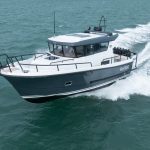‘Behemoth’ is a word which springs to mind or, perhaps more nautically, ‘leviathan’.
- Elite #8 for Scott Lane Boatbuilders
- Fuel tank forms part of the hull structure
- 20-knot cruise speed
- Huge flybridge
- Sport fishing cockpit
- Luxury interior
- Hard-out sportfisher from the rear bulkhead aft
- Practical family cruiser forward
- Plenty of battery capacity for quiet ship running










